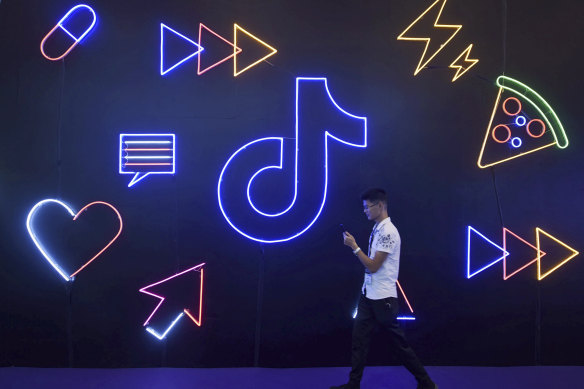Save articles for later
Add articles to your saved list and come back to them any time.
TikTok employees in the United States have expressed frustration and dismay after the company introduced a tool for tracking office attendance and threatened disciplinary action for failing to comply with new in-person mandates, in an unusual effort to get workers back into the office with custom data-collection technology.
Employees at TikTok, which is owned by Chinese company ByteDance, received notices last week about the new tool, an app called MyRTO. The app, which is built into the company’s internal software, monitors badge swipes and asks employees to explain “deviations” – absences on days they are meant to be in the office – according to emails and screenshots shared with The New York Times.
Employees at TikTok received notices last week about a new app called MyRTO that tracks office attendance.Credit: AP
A dashboard with the data is visible to employees, their supervisors and human resource staff members.
TikTok requires many of its roughly 7000 US employees to work in offices three times a week beginning in October. Some teams are expected in five days a week. Employees were told that “any deliberate and consistent disregard may result in disciplinary action” and could “impact on performance reviews”.
TikTok’s workers have been taken aback by the disciplinarian tone of the messaging and the appearance of the MyRTO dashboard, which serves as a reminder that the company is monitoring their daily whereabouts, according to interviews with multiple employees, who would speak only anonymously. One of the employees, who said some in-person work was important, added that the app and threats of punishment were unnecessary and that colleagues were now fearful about the consequences of failing to comply.
Zach Dunn, an expert on hybrid work and a founder of the hybrid management company Robin, said it was “exceedingly rare” for companies to monitor badge swipes so closely and to threaten disciplinary action on attendance.
“We’ve seen folks say, ‘This will be considered as part of your overall performance evaluation,’” he said. “That’s different from saying, ‘If you don’t do this, you will be disciplined.’”
Jodi Seth, a spokesperson for TikTok, said the tool was meant to help set expectations for in-office attendance.
“The ultimate goal of MyRTO is to provide greater clarity and context to both employees and leaders regarding their RTO expectations and in-office schedules and help foster more transparent communications,” Seth said.
More than three years into the saga of return-to-office planning, many companies have settled into hybrid work arrangements. Just over a quarter of workdays performed by US workers are done from home, according to research from Stanford University, and offices across the country remain under 50 per cent of their pre-pandemic occupancy, according to Kastle, a workplace security firm.
Many tech companies, including Zoom and Meta, have asked employees to start reporting to the office this northern summer and autumn. Some of these policies have provoked pushback, including at Amazon, where corporate employees staged a walkout in May.
‘We’ve seen folks say, “This will be considered as part of your overall performance evaluation”… That’s different from saying, “If you don’t do this, you will be disciplined.” ’
Some companies are tightening their enforcement efforts, indicating they will monitor badge swipes to ensure employees are showing up. Google, which asked most of its employees to be in the office three days a week, will use badge swipes to identify prolonged absences from the office, which could be incorporated into performance review conversations.
But few companies have created custom tools and dashboards with daily logs of that data for employees and their managers.
TikTok has employees in US cities including Los Angeles, Washington and New York. The company grew significantly during the pandemic but has struggled to get its far-flung workforce into its offices.
In an email to employees that introduced MyRTO, TikTok described its goals for in-office work and said that “we are now providing the next suite of tools and information for both employees and leaders to better allocate time spent in the office optimising collaboration”.
In August, the company told New York employees that a lunch stipend would be linked to an app that required a check-in from the office for access to the funds, according to two of the workers who spoke on the condition of anonymity. The employees said the app felt like another way to check on their location.
Dunn said TikTok’s attitude toward in-person work might be influenced by TikTok and ByteDance’s overseas leadership. He cited data from his firm showing that workers in the Asia-Pacific region have largely resumed their pre-pandemic commutes.
“For companies, especially where they have leadership based in this region, they probably don’t see what the big deal is because they’ve been doing this for well over a year,” Dunn said. “The expectation is the office.”
This article originally appeared in The New York Times.
The Business Briefing newsletter delivers major stories, exclusive coverage and expert opinion. Sign up to get it every weekday morning.
Most Viewed in Business
From our partners
Source: Read Full Article
